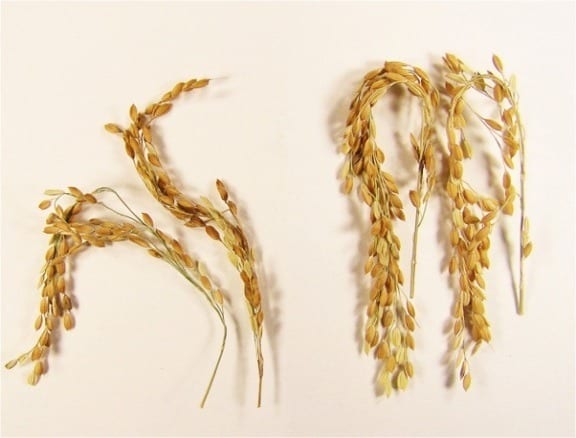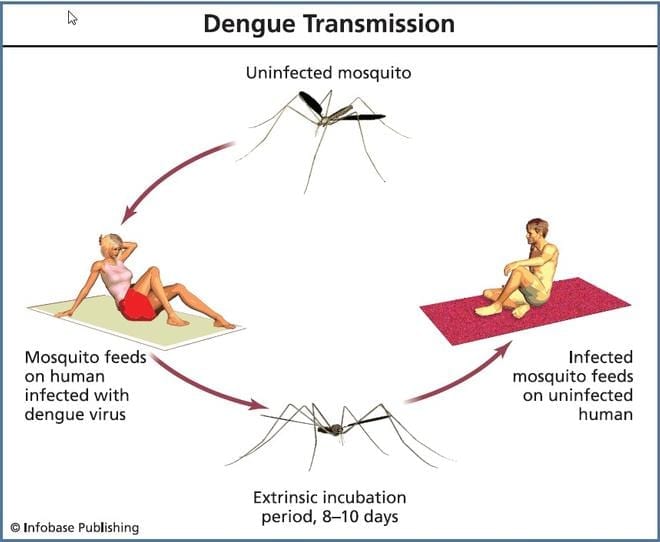
Image courtesy of Swedish University of Agricultural Sciences
Discovery delivers high starch content, virtually no methane emissions
Rice serves as the staple food for more than half of the world’s population, but it’s also the one of the largest manmade sources of atmospheric methane, a potent greenhouse gas. Now, with the addition of a single gene, rice can be cultivated to emit virtually no methane from its paddies during growth. It also packs much more of the plant’s desired properties, such as starch for a richer food source and biomass for energy production, according to a study in Nature.
With their warm, waterlogged soils, rice paddies contribute up to 17 percent of global methane emissions, the equivalent of about 100 million tons each year. While this represents a much smaller percentage of overall greenhouse gases than carbon dioxide, methane is about 20 times more effective at trapping heat. SUSIBA2 rice, as the new strain is dubbed, is the first high-starch, low-methane rice that could offer a significant and sustainable solution.
Researchers created SUSIBA2 rice by introducing a single gene from barley into common rice, resulting in a plant that can better feed its grains, stems and leaves while starving off methane-producing microbes in the soil.
The results, which appear in the July 30 print edition of Nature andonline, represent a culmination of more than a decade of work by researchers in three countries, including Christer Jansson, director of plant sciences at the Department of Energy’s Pacific Northwest National Laboratory and EMSL, DOE’s Environmental Molecular Sciences Laboratory. Jansson and colleagues hypothesized the concept while at the Swedish University of Agricultural Sciences and carried out ongoing studies at the university and with colleagues at China’s Fujian Academy of Agricultural Sciences and Hunan Agricultural University.
“The need to increase starch content and lower methane emissions from rice production is widely recognized, but the ability to do both simultaneously has eluded researchers,” Jansson said. “As the world’s population grows, so will rice production. And as the Earth warms, so will rice paddies, resulting in even more methane emissions. It’s an issue that must be addressed.”
Read more: Tiny grains of rice hold big promise for greenhouse gas reductions, bioenergy
The Latest on: SUSIBA2 rice
[google_news title=”” keyword=”SUSIBA2 rice” num_posts=”10″ blurb_length=”0″ show_thumb=”left”]
via Google News
The Latest on: SUSIBA2 rice
- Chiefs' Rashee Rice surrenders to police on charges from crashon April 11, 2024 at 8:21 pm
GLENN HEIGHTS, Texas -- Kansas City Chiefs wide receiver Rashee Rice surrendered to police Thursday on charges including aggravated assault after he and another driver of a speeding sports car ...
- Rashee Rice turns himself into police after alleged role in hit-and-runon April 11, 2024 at 7:38 pm
Kansas City Chiefs wide receiver Rashee Rice turned himself into police on Thursday following his alleged involvement in a hit-and-run, records show. Rice was driving a Lamborghini, and Theodore ...
- Chiefs' Rashee Rice faces aggravated assault, seven more charges over multi-car crashon April 10, 2024 at 5:35 pm
Dallas Police formally issued an arrest warrant Wednesday for Kansas City Chiefs wide receiver Rashee Rice for his role in a multi-car crash that sent two people to the hospital. Rice is facing ...
- Arrest warrant issued for Chiefs’ Rashee Rice after Dallas crashon April 10, 2024 at 5:31 pm
A warrant has been issued for Chiefs wide receiver Rashee Rice over his involvement in a March 30 multi-car crash in Dallas, WFAA reported Wednesday. Rice, 23, is facing eight charges in ...
- Chiefs wide receiver Rashee Rice turns himself in to police after warrant issued for multi-car crash in Dallason April 10, 2024 at 3:09 pm
DALLAS — Kansas City Chiefs wide receiver Rashee Rice turned himself in Thursday evening. Rice turned himself in to the Glen Heights Police. He is being processed at the Tri City Jail in DeSoto.
- There’s still some unknown about the Rashee Rice crash. But the known is inexcusableon April 4, 2024 at 10:30 pm
Royce West, the attorney and Texas state senator representing Chiefs wide receiver Rashee Rice, stepped in front of a collection of microphones at 1:34 p.m. Thursday. By 1:36 p.m., he’d cleared ...
- Who is Rashee Rice? Here are 5 things to know about the Kansas City Chiefs WRon April 4, 2024 at 3:07 pm
Rashee Rice met with Dallas police on Wednesday and took “full responsibility” for his part in the six-vehicle crash at about 6:20 p.m. in the 6600 block of North Central Expressway.
- Chiefs’ Rashee Rice meets with police, takes ‘full responsibility’ for six-vehicle Dallas crashon April 3, 2024 at 3:41 pm
Chiefs wide receiver Rashee Rice took “full responsibility” for his involvement in a six-vehicle accident on Saturday in Dallas, which left multiple people injured and a 4-year-old boy shaking ...
- Rashee Rice’s Attorney Says the Chiefs Player Is Now ‘Cooperating’ with Police After 6-Car Collision and Police Searchon April 1, 2024 at 4:13 pm
In a statement to PEOPLE, senator and attorney Royce West said Rice’s “thoughts are with everyone impacted” in the accident Brian Anthony Hernandez, who has nearly 20 years of journalism ...
- Rashee Rice wanted by police over investigation into 'serious' car accident: What to knowon March 31, 2024 at 8:01 am
Dallas Police are currently searching for Kansas City Chiefs wide receiver and 2023 second-round pick Rashee Rice as they continue an investigation into a serious car accident that involved a ...
via Bing News










